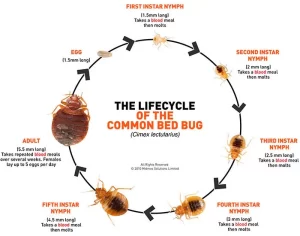Bed bugs are never good news. These blood-sucking critters have a bad reputation. And it is a well-earned one because bed bugs are not only nasty, but they're also hard to find and can be even tougher to eradicate.
You may be familiar with what adult bed bugs look like, but what about babies? Or eggs for that matter? The more you know about the bed bug life cycle, the more likely you'll be to catch an infestation early and deal with it correctly (by calling the pros at GL Pest Control, of course).
So, read on to arm yourself with some quintessential bed bug knowledge and find out what bed bugs look like and how they behave at every stage of development.
Like all insects, bed bugs begin as eggs, then hatch out as nymphs, and finally become adults. Entomology lesson aside, you may find that this information becomes highly relevant if and when you have the misfortune of discovering a possible bed bug - or bed bug infestation in your home.
Bed bug eggs are tiny and white. Each one measures approximately 1mm long, which is about the length of two grains of salt. An adult female bed bug can lay one to five eggs per day and may lay up to five hundred eggs in her lifetime! Yikes.

Eggs can be laid singly or may be found in clusters. They are usually located in the same places where adult bed bugs are found - dry cracks, crevices, and seams in your flooring, carpet, mattress, box spring, or upholstered furniture. They can also be found behind picture frames, headboards or baseboards, under peeling wallpaper, or inside electrical outlets.
It takes less than two weeks for bed bug eggs to hatch, at which point little nymphs emerge...and begin to look for food.
Bed bug nymphs look like small adult bed bugs except that they are yellowish in colour instead of reddish-brown like full-grown adults. They must molt five times in order to reach maturity, and each time they molt, they become a little darker in colour. Something else also happens each time they molt: A blood meal.
Yes, it's true. In order for baby bed bugs to grow, they must feed on blood. Ingesting blood allows them to molt out of their skin and leave it behind (molted bed bug skins are another sign of bed bugs to watch out for, by the way). And this happens five times before baby bed bugs reach sexual maturity. In total, this process takes approximately five weeks at room temperature.
Interestingly, the bed bug life cycle slows down (takes longer) in colder temperatures.
Adult bed bugs are nocturnal, reddish-brown pests about the size and shape of an apple seed. Their flat shape allows them to hide undetected in small cracks and crevices throughout your household's interior.
Adult bed bugs feed approximately once per week (they can go longer between feedings the older they get) and live between 4-6 months under normal conditions. They do not live in isolation, so where you find one adult bed bug, there are likely more - not to mention eggs, nymphs, shed skins, and feces.
Baby bed bugs live in dry cracks and crevices in the interior of your home. Eggs and nymphs can be tricky to spot because they are able to thrive in hard-to-examine environments like seams, electrical outlets, and the insides of box springs.
If you suspect you may have a bed bug problem, examine these areas carefully and look for evidence of bed bug activity at any stage of their life cycle.
Yes. Baby bed bugs (nymphs) must feed on blood as soon they hatch out of their eggs and then again each of the five times they molt. They are attracted to human hosts because of our warmth and the carbon dioxide we exhale.
Bed bug bites look much like other insect bites. They are often, but not always, grouped together and smaller than mosquito bites. Bed bug bites are itchy and may become inflamed, red, or blistered.
Prevention strategies are key in keeping bed bugs at bay. Be sure to always inspect second-hand clothing and furniture carefully before bringing it into your home. In addition, take precautions when sleeping away. Check hotel rooms for signs of bed bugs and keep your luggage on a rack pulled away from the wall. When you return home, wash your clothing immediately and dry it using the highest setting possible.
If you suspect you’ve found evidence of bed bugs in your home, act quickly to mitigate potential harm and damage. Call a bed bug exterminator right away for advice on how to proceed. Usually, bed bug removal is a multi-step process best left to the experts.



